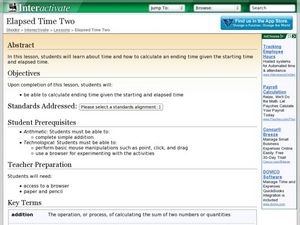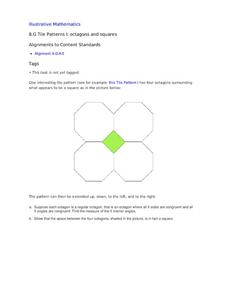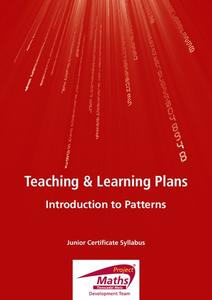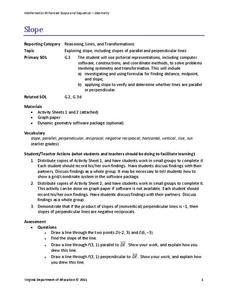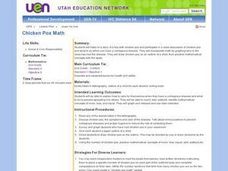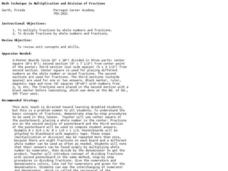Curated OER
Probability Of One Event
Students investigate the concept of probability. They use example problems in order to measure the likelihood of various outcomes. The lesson includes dialogue to be used by the teacher during direct instruction. They also use class...
Curated OER
Similarity
Students engage in a activity that is concerned with the concept of similarity. This takes higher order thinking skills and being able to separate into categories. Specifically in this activity they are introduced to the scale and how it...
Curated OER
Elapsed Time Two
Learners study how to calculate elapsed time. For this elapsed time lesson, they determine how to calculate the ending time of an event when they are given the starting time and the elapsed time. They participate in direct instruction,...
Curated OER
Three-Digit Addition
Young scholars work with hundreds place value, create and manipulate three-digit addition problems, and add three-digit numbers.
West Contra Costa Unified School District
The Power of Ten: Building a Magnitude Model
Add visual representation to teaching place value with a magnitude model. Using adding machine tape, pupils build a linear place value strip from 1 to 100.
EngageNY
Criterion for Perpendicularity
The Pythagorean Theorem is a geometry pupil's best friend! Learners explain the equation a1b1 + a2b2 = 0 for perpendicular segments using the Pythagorean Theorem. They are able to identify perpendicular segments using their...
EngageNY
Normal Distributions (part 2)
From z-scores to probability. Learners put together the concepts from the previous lessons to determine the probability of a given range of outcomes. They make predictions and interpret them in the context of the problem.
Curated OER
Tile Patterns I: Octagons and Squares
This can be used as a critical thinking exercise in congruence or as a teaching tool when first introducing the concept. Four octagons are arranged in such a way that a square is formed in the middle. With this information, geometry...
Project Maths
Introduction to Patterns
The world is full of patterns. Help learners quantify those patterns with mathematical representations. The first Algebra lesson in a compilation of four uses a series of activities to build the concept of patterns using multiple...
02 x 02 Worksheets
Slope
What does slope have to do with lines? Pupils work with lines and determine the slope of the lines informally and with the slope formula. Groups use their knowledge to calculate the slopes of parallel and perpendicular lines. They also...
Curated OER
Two Step Equations
Sixth graders solve multiple step math problems. In this problem solving lesson, 6th graders practice following step by step instructions such as making cookies or building a snowman. Students use algebra tiles and draw pictures to solve...
Curated OER
Following Plans
Students learn to follow a specific plan in order to do something or get somewhere. In this following directions activity, students explore key vocabulary related to following plans, complete fun activities that require attention to...
Curated OER
"Aye, Aye, Captain!"
Students explore direction by reading sailing stories in class. In this navigation lesson, students identify the techniques used by sailors in order to travel safely and accurately. Students read stories about sailing in class and define...
Curated OER
Student D
Students are being evaluated on their math skills. For this algebra lesson, students review basic math skills and are being reviewed for leaning skills that may enhance or inhibit their learning skills. They are scored based on a special...
Curated OER
Writing Directions for Mathematical Activities
Fifth graders reorganize comic strips to have them make sense, complete outline and organize their thoughts into outline form to explain directions,
and use that outline to complete their own directions for geometry activities.
Dick Blick Art Materials
Painted Story Quilt
Creating story quilts is a great way to combine art, social studies and literature. Kids select a story, a published one or one of their own, to illustrate, paint on a canvas square, embellish, and mount on a felt backing.
Curated OER
Data Analysis Using Technology
Analyze data using technology. Middle schoolers design data investigations, describe data, and draw their own conclusions. Then they select the best type of graph, graph and interpret the data, and look for patterns in trends. They also...
Curated OER
Hoot: Vocabulary: Magic Squares
Define words with numbers in a fun vocabulary activity. Using words from Hoot by Carl Hiaasen, learners use a grid to match words and their definitions, and to find the magic number that is the same when the numbers are added from...
Curated OER
Chicken Pox Math
Second graders are read a story about a boy with chicken pox. As a class, they discuss what to do when you have a contagious disease and identify who in the class has had chicken pox. Using this information, they create a graph and use...
Curated OER
Math Skills for Everyday: Filling Out Income Tax Forms
Students accurately assess their own income taxes using actual tax forms. They read and fill out the proper forms.
Curated OER
Math Technique in Multiplication and Division of Fractions
Young scholars multiply and divide fractions. In this math lesson, students are given explicit visual instruction of how to work with fractions. Intended for learning disabled young scholars, the teacher demonstrates how to manipulate...
Curated OER
Math: a World of Symmetry
Students expand their knowledge of quadrilaterals and identify basic symmetrical forms. Over three weeks, they explore the math, application, and discussion of symmetry. After conducting Internet research, students create symmetrical...
Curated OER
Math Manipulative: "Fraction Sticks"
Fifth graders use sets of fraction sticks to color in fractional amounts and determine how to compare pairs of fractions. In this math activity, 5th graders insert the correct symbol given the fractions they are working with....
K20 LEARN
Do Placebos Kill Minotaurs?
But it's just a game! Learners play a game to learn basic concepts of statistical hypothesis testing. After using the digital-game module, pupils develop their own statistical hypotheses and test them.


